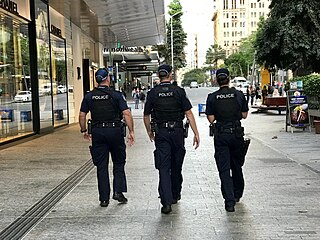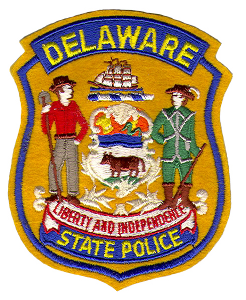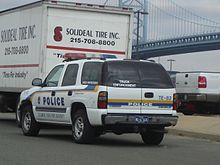
The Delaware River Port Authority (DRPA), officially the Delaware River Port Authority of Pennsylvania and New Jersey, is a bi-state agency instrumentality created by a congressionally approved interstate compact between the state governments of Pennsylvania and New Jersey. The authority is principally charged to maintain and develop transportation links between the two states with four bridges and a mass transit rail line across the Delaware River. Though the DRPA has "port" in its name, it does not own or operate any ports.
In the United States, an interstate compact is a pact or agreement between two or more states, or between states and any foreign sub-national government.

The Delaware River and Bay Authority (DRBA) is a bi-state government agency of the U.S. states of Delaware and New Jersey established by an interstate compact in 1962.
Railroad police or railway police are people responsible for the protection of railroad properties, facilities, revenue, equipment, and personnel, as well as carried passengers and cargo. Railroad police may also patrol public rail transit systems.

Transit police are specialized police agencies employed either by a common carrier, such as a transit district, railway, railroad, bus line, or another mass transit provider or municipality, county, district, or state.

The Delaware Memorial Bridge is a dual-span suspension bridge crossing the Delaware River. The toll bridges carry Interstate 295 and U.S. Route 40 and is also the link between Delaware and New Jersey. The bridge was designed by the firm of Howard, Needles, Tammen & Bergendoff with consulting help from engineer Othmar Ammann, whose other designs include the George Washington Bridge and the Verrazzano-Narrows Bridge.
Special police usually describes a police force or unit within a such an agency whose duties and responsibilities are significantly different from other forces in the same country or from other personnel within the same agency, although there is no consistent international definition. Generally, special police personnel hold some level of police powers; sometimes they hold the same powers and authority of other law enforcement officers within their jurisdiction, but at a minimum they will typically possess detainment and arrest authority. 'Special police' is also occasionally used when referring to an 'elite' law enforcement agency or unit, such as special weapons and tactics (SWAT) units or other similar paramilitary forces who have some level of police power. 'Special police' may also be used to describe individuals who are granted police powers incidental to their primary duties, such as welfare fraud investigators, certain security guards, child welfare investigators, and agricultural inspectors. Special police personnel may be armed or unarmed.

State police, provincial police or regional police are a type of sub-national territorial police force found in nations organized as federations, typically in North America, South Asia, and Oceania. These forces typically have jurisdiction over the relevant sub-national jurisdiction, and may cooperate in law enforcement activities with municipal or national police where either exist.

Water police, also called bay constables, coastal police, harbor patrols, marine/maritime police/patrol, nautical patrols, port police, or river police are a specialty law enforcement portion of a larger police organization, who patrol in water craft. Their patrol areas may include coastal tidal waters, rivers, estuaries, harbors, lakes, canals or a combination of these.

The Delaware State Police (DSP) is a division of the Delaware Department of Public Safety and Homeland Security and is responsible for traffic regulation and law enforcement across the US State of Delaware, especially in areas underserved by local police departments. The DSP is headquartered in the capital Dover, Delaware.

The Maryland State Police (MSP), officially the Maryland Department of State Police (MDSP), is the official state police force of the U.S. state of Maryland. The Maryland State Police is headquartered at 1201 Reisterstown Road in the Pikesville CDP in unincorporated Baltimore County.

The Port Authority of New York and New Jersey Police Department, or Port Authority Police Department (PAPD), is a law enforcement agency in New York and New Jersey, the duties of which are to protect and to enforce state and city laws at all the facilities, owned or operated by the Port Authority of New York and New Jersey (PANYNJ), the bi-state agency running airports, seaports, and many bridges and tunnels within the Port of New York and New Jersey. Additionally, the PAPD is responsible for other PANYNJ properties including three bus terminals, the World Trade Center in Lower Manhattan, and the PATH train system. The PAPD is the largest transit-related police force in the United States.

As of 2024, more than 1,280,000 sworn law enforcement officers are serving in the United States. About 137,000 of those officers work for federal law enforcement agencies.

The Metro Transit Police Department (MTPD) is the transit police agency of the Washington Metropolitan Area Transit Authority (WMATA), created by the WMATA Compact on June 4, 1976.

The Maryland Transportation Authority Police is the eighth-largest law enforcement agency in the U.S. state of Maryland and is charged with providing law enforcement services on Maryland Transportation Authority highways and facilities throughout the state, in addition to contractual services that are provided at Baltimore–Washington International Thurgood Marshall Airport, and the Port of Baltimore.

Airport police units are a security police agency assigned to perform law enforcement functions at airports. They provide a wide range of law enforcement duties and responsibilities including patrol, investigation, traffic flow management, and control and response to airport emergencies. Airport police provide enhanced safety to airport employees, and to passengers. Officers can be found at security gates, throughout the terminal area, and around the airport’s perimeter.

Sheriffs In the United States are the chief of law enforcement officers of a county. Sheriffs are usually either elected by the populace or appointed by an elected body.
Law enforcement in New York City is carried out by numerous federal, state, city and private agencies. New York City has the highest concentration of law enforcement in the United States.

In the United States, the state police is a police body unique to each U.S. state, having statewide authority to conduct law enforcement activities and criminal investigations. In general, state police officers or highway patrol officers, known as state troopers, perform functions that do not fall within the jurisdiction of a county’s sheriff, such as enforcing traffic laws on state highways and interstates, overseeing security of state capitol complexes, protecting governors, training new officers for local police forces too small to operate an academy and providing technological and scientific services. They also support local police and help to coordinate multi-jurisdictional task force activity in serious or complicated cases in states that grant full police powers statewide.































